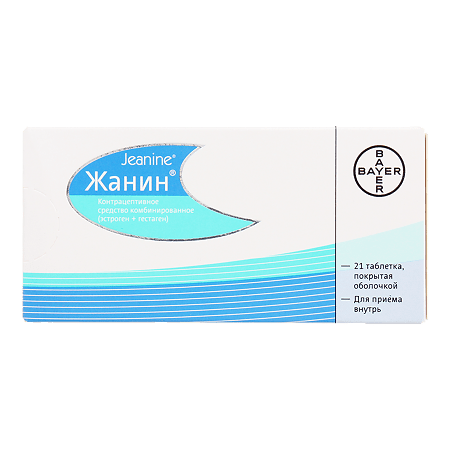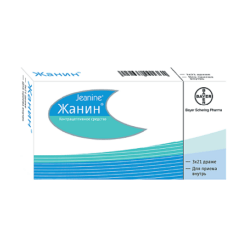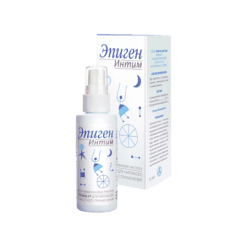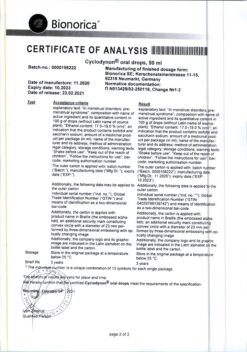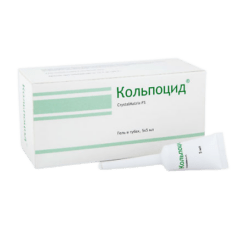No products in the cart.
Jeanine, 2 mg+0.03 mg 21 pcs
€33.53 €27.94
EAN: 4029668001101
SKU: 205908
Categories: Contraceptive, Gynecology and Obstetrics, Hormonal, Medicine
Description
Pharmacodynamics
The contraceptive effect of Gynine is achieved through various complementary mechanisms, the most important of which are suppression of ovulation and changes in cervical mucus viscosity, making it impermeable to sperm.
When used correctly, the Perl Index (a measure of the number of pregnancies in 100 women taking the contraceptive in a year) is less than 1. If the pill is missed or used incorrectly, the Perl index may increase.
The gestagenic component of Janine, dienogest, has antiandrogenic activity, which has been confirmed by a number of clinical studies. In addition, dienogestr improves the lipid profile of the blood (increases the number of HDLs).
In women taking combined oral contraceptives menstrual cycle becomes more regular, painful menstruation is less often observed, the intensity and duration of bleeding decreases, and as a result the risk of iron deficiency anemia decreases. There is also evidence of a decreased risk of endometrial and ovarian cancer.
Pharmacokinetics
Dienogest
Absorption. When taken orally, dienogest is rapidly and completely absorbed; its Cmax in serum, equal to 51 ng/mL, is reached after approximately 2.5 hours. The bioavailability is approximately 96%.
Distribution. Dienogest is bound to serum albumin and does not bind to sex steroid-binding globulin (SBSG) and corticoid-binding globulin (CRBG). Free is about 10% of the total serum concentration; about 90% is nonspecifically bound to serum albumin. Induction of HSPC synthesis by ethinylestradiol has no effect on dienogestin binding to serum albumin.
Metabolism. Dienogest is almost completely metabolized. Serum clearance after a single dose is approximately 3.6 l/h.
Elimination. T1/2 from plasma is approximately 8.5-10.8 h. In the unchanged form it is excreted in the urine in insignificant amounts; as metabolites – by the kidneys and through the gastrointestinal tract in a ratio of about 3:1 with T1/2 – 14.4 h.
The equilibrium concentration. The pharmacokinetics of dienogest is not affected by serum HSPC levels. Daily administration of the drug increases the level of the substance in the serum by approximately 1.5 times.
Ethinylestradiol
Absorption. After oral administration, ethinylestradiol is quickly and completely absorbed. Cmax in serum, equal to approximately 67 ng/mL, is reached in 1.5-4 hours. During absorption and first passage through the liver, ethinylestradiol is metabolized, resulting in an average bioavailability of about 44% when taken orally.
Distribution. Ethinylestradiol is almost completely (approximately 98%), although non-specific, bound to albumin. Ethinylestradiol induces the synthesis of HSPC. The apparent volume of distribution of ethinylestradiol is 2.8-8.6 L/kg.
Metabolism. Ethinylestradiol undergoes presystemic biotransformation both in the small intestinal mucosa and in the liver. The main metabolic pathway is aromatic hydroxylation. The blood plasma clearance rate is 2.3-7 ml/min/kg.
Evacuation. The decrease in the concentration of ethinylestradiol in blood serum has a biphasic character; the first phase is characterized by T1/2 about 1 h, the second by T1/2 10-20 h. It is not excreted from the body unchanged. Metabolites of ethinylestradiol are excreted with urine and bile in the ratio of 4:6 with T1/2 about 24 h.
The equilibrium concentration. Equilibrium concentration is reached during the second half of the treatment cycle.
Indications
Indications
Hormonal contraception.
Pharmacological effect
Pharmacological effect
Pharmacodynamics
The contraceptive effect of Janine is carried out through various complementary mechanisms, the most important of which are the suppression of ovulation and a change in the viscosity of cervical mucus, as a result of which it becomes impermeable to sperm.
When used correctly, the Pearl index (an indicator reflecting the number of pregnancies in 100 women taking a contraceptive during the year) is less than 1. If pills are missed or used incorrectly, the Pearl index may increase.
The gestagenic component of Janine, dienogest, has antiandrogenic activity, which is confirmed by the results of a number of clinical studies. In addition, dienogest improves the blood lipid profile (increases the amount of HDL).
In women taking combined oral contraceptives, the menstrual cycle becomes more regular, painful menstruation is less frequent, the intensity and duration of bleeding decreases, resulting in a reduced risk of iron deficiency anemia. In addition, there is evidence of a reduced risk of endometrial and ovarian cancer.
Pharmacokinetics
Dienogest
Absorption. When taken orally, dienogest is rapidly and completely absorbed, its Cmax in the blood serum of 51 ng/ml is achieved after approximately 2.5 hours. Bioavailability is approximately 96%.
Distribution. Dienogest binds to serum albumin and does not bind to sex steroid binding globulin (SGBS) and corticoid binding globulin (CBG). About 10% of the total concentration in the blood serum is found in free form; about 90% are nonspecifically associated with serum albumin. Induction of SHPS synthesis by ethinyl estradiol does not affect the binding of dienogest to serum albumin.
Metabolism. Dienogest is almost completely metabolized. Serum clearance after a single dose is approximately 3.6 L/h.
Excretion. T1/2 from plasma is about 8.5–10.8 hours. In unchanged form, it is excreted in the urine in small quantities; in the form of metabolites – by the kidneys and through the gastrointestinal tract in a ratio of approximately 3:1 with T1/2 – 14.4 hours.
Equilibrium concentration. The pharmacokinetics of dienogest is not affected by the level of SHPS in the blood serum. As a result of daily administration of the drug, the level of the substance in the serum increases approximately 1.5 times.
Ethinyl estradiol
Absorption. After oral administration, ethinyl estradiol is rapidly and completely absorbed. Serum Cmax of approximately 67 ng/ml is achieved in 1.5–4 hours. During absorption and first passage through the liver, ethinyl estradiol is metabolized, resulting in its oral bioavailability averaging about 44%.
Distribution. Ethinyl estradiol is almost completely (approximately 98%), although nonspecifically, bound by albumin. Ethinyl estradiol induces the synthesis of GSPC. The apparent volume of distribution of ethinyl estradiol is 2.8–8.6 l/kg.
Metabolism. Ethinyl estradiol undergoes presystemic biotransformation both in the mucosa of the small intestine and in the liver. The main route of metabolism is aromatic hydroxylation. The clearance rate from blood plasma is 2.3–7 ml/min/kg.
Excretion. The decrease in the concentration of ethinyl estradiol in the blood serum is biphasic; the first phase is characterized by T1/2 of about 1 hour, the second – T1/2 of 10–20 hours. It is not excreted from the body unchanged. Metabolites of ethinyl estradiol are excreted in urine and bile in a ratio of 4:6 with T1/2 for about 24 hours.
Equilibrium concentration. Equilibrium concentration is achieved during the second half of the treatment cycle.
Special instructions
Special instructions
If any of the conditions, diseases and risk factors listed below currently exist, the potential risks and expected benefits of combined oral contraceptives should be carefully weighed in each individual case and discussed with the woman before she decides to start taking the drug. In the event of worsening, intensification or the first manifestation of any of these conditions, diseases or an increase in risk factors, the woman should consult with her doctor, who may decide whether to discontinue the drug.
Diseases of the cardiovascular system
The results of epidemiological studies indicate a relationship between the use of COCs and an increased incidence of venous and arterial thrombosis and thromboembolism (such as deep vein thrombosis, pulmonary embolism, myocardial infarction, cerebrovascular disorders) when taking combined oral contraceptives. These diseases are rare.
The risk of developing venous thromboembolism (VTE) is greatest in the first year of taking such drugs. An increased risk is present after initial use of combined oral contraceptives or resumption of use of the same or different combined oral contraceptives (after a dosing interval of 4 weeks or more). Data from a large prospective study involving 3 groups of patients indicate that this increased risk is predominantly present during the first 3 months.
The overall risk of VTE in patients taking low-dose combined oral contraceptives (ethinyl estradiol content –
VTE, manifested as deep vein thrombosis, or pulmonary embolism can occur with the use of any combined oral contraceptives.
It is extremely rare that when using combined oral contraceptives, thrombosis of other blood vessels (for example, hepatic, mesenteric, renal, cerebral veins and arteries or retinal vessels) occurs. There is no consensus regarding the relationship between the occurrence of these events and the use of combined oral contraceptives.
Symptoms of deep vein thrombosis (DVT) include the following: unilateral swelling of the lower extremity or along a vein in the leg, pain or discomfort in the leg only when standing up or when walking, localized warmth in the affected leg, redness or discoloration of the skin on the leg.
Symptoms of pulmonary embolism (PE) include: difficulty or rapid breathing; sudden cough, incl. with hemoptysis; sharp pain in the chest, which may intensify with deep inspiration; feeling of anxiety; severe dizziness; fast or irregular heartbeat. Some of these symptoms (eg shortness of breath, cough) are non-specific and may be misinterpreted as signs of other more or less severe events (eg respiratory tract infection).
Arterial thromboembolism can lead to stroke, vascular occlusion, or myocardial infarction. Symptoms of a stroke include: sudden weakness or loss of feeling in the face, arm or leg, especially on one side of the body, sudden confusion, problems with speech and comprehension; sudden unilateral or bilateral vision loss; sudden disturbance in gait, dizziness, loss of balance or coordination; sudden, severe or prolonged headache for no apparent reason; loss of consciousness or fainting with or without an epileptic seizure. Other signs of vascular occlusion: sudden pain, swelling and slight blue discoloration of the extremities, acute abdomen.
Symptoms of myocardial infarction include: pain, discomfort, pressure, heaviness, a feeling of squeezing or fullness in the chest, arm, or chest; discomfort radiating to the back, cheekbone, larynx, arm, stomach; cold sweat, nausea, vomiting or dizziness, severe weakness, anxiety or shortness of breath; fast or irregular heartbeat. Arterial thromboembolism can be fatal. The risk of developing thrombosis (venous and/or arterial) and thromboembolism increases:
– with age;
– in smokers (with an increase in the number of cigarettes or an increase in age, the risk increases, especially in women over 35 years of age).
If available:
– obesity (body mass index more than 30 kg/m2);
– family history (for example, venous or arterial thromboembolism ever in close relatives or parents at a relatively young age). In the case of a hereditary or acquired predisposition, the woman should be examined by an appropriate specialist to decide on the possibility of taking combined oral contraceptives;
– prolonged immobilization, major surgery, any leg surgery or major trauma. In these situations, it is advisable to stop using combined oral contraceptives (in the case of planned surgery, at least 4 weeks before it) and not resume use for two weeks after the end of immobilization;
– dislipoproteinemia;
– arterial hypertension;
– migraine;
– diseases of the heart valves;
– atrial fibrillation.
The possible role of varicose veins and superficial thrombophlebitis in the development of venous thromboembolism remains controversial.
The increased risk of thromboembolism in the postpartum period should be taken into account.
Poor peripheral circulation may also occur in diabetes mellitus, systemic lupus erythematosus, hemolytic uremic syndrome, chronic inflammatory bowel disease (Crohn’s disease or ulcerative colitis) and sickle cell anemia.
An increase in the frequency and severity of migraine during use of combined oral contraceptives (which may precede cerebrovascular events) may be grounds for immediate discontinuation of these drugs.
Biochemical indicators indicating a hereditary or acquired predisposition to venous or arterial thrombosis include the following: resistance to activated protein C, hyperhomocysteinemia, antithrombin III deficiency, protein C deficiency, protein S deficiency, antiphospholipid antibodies (anticardiolipin antibodies, lupus anticoagulant).
When assessing the risk-benefit ratio, it should be taken into account that adequate treatment of the relevant condition may reduce the associated risk of thrombosis. It should also be taken into account that the risk of thrombosis and thromboembolism during pregnancy is higher than when taking low-dose oral contraceptives (ethinyl estradiol content –
Tumors
The most significant risk factor for developing cervical cancer is persistent human papillomavirus infection. There are reports of a slight increase in the risk of developing cervical cancer with long-term use of combined oral contraceptives. However, the connection with the use of combined oral contraceptives has not been proven. Controversy remains regarding the extent to which these findings are related to screening for cervical pathology or to sexual behavior (lower use of barrier methods of contraception).
A meta-analysis of 54 epidemiological studies found that there is a slightly increased relative risk of developing breast cancer diagnosed in women who used combined oral contraceptives (relative risk – 1.24). The increased risk gradually disappears within 10 years of stopping these drugs. Because breast cancer is rare in women under 40 years of age, the increase in breast cancer diagnoses in women currently or recently taking combined oral contraceptives is small relative to the overall risk of breast cancer. Its connection with the use of combined oral contraceptives has not been proven. The observed increased risk may also be a consequence of earlier diagnosis of breast cancer in women using combined oral contraceptives. Women who have ever used combined oral contraceptives are diagnosed with earlier stages of breast cancer than women who have never used them.
In rare cases, during the use of combined oral contraceptives, the development of liver tumors has been observed, which in some cases led to life-threatening intra-abdominal bleeding. In case of severe abdominal pain, liver enlargement or signs of intra-abdominal bleeding, this should be taken into account when making a differential diagnosis.
Other states
Women with hypertriglyceridemia (or a family history of this condition) may have an increased risk of developing pancreatitis while taking combined oral contraceptives.
Although slight increases in blood pressure have been described in many women taking combined oral contraceptives, clinically significant increases have rarely been reported. However, if a persistent, clinically significant increase in blood pressure develops while taking combined oral contraceptives, these drugs should be discontinued and treatment of arterial hypertension should be initiated. Taking combined oral contraceptives can be continued if normal blood pressure values are achieved with antihypertensive therapy.
The following conditions have been reported to develop or worsen both during pregnancy and while taking combined oral contraceptives, but their association with combined oral contraceptives has not been proven: jaundice and/or pruritus associated with cholestasis; formation of gallstones; porphyria; systemic lupus erythematosus; hemolytic uremic syndrome; chorea; herpes during pregnancy; hearing loss associated with otosclerosis. Cases of Crohn’s disease and ulcerative colitis have also been described during the use of combined oral contraceptives.
In women with hereditary forms of angioedema, exogenous estrogens may cause or worsen symptoms of angioedema.
Acute or chronic liver dysfunction may require discontinuation of combined oral contraceptives until liver function tests return to normal. Recurrent cholestatic jaundice, which develops for the first time during pregnancy or previous use of sex hormones, requires discontinuation of combined oral contraceptives.
Although combined oral contraceptives may have an effect on insulin resistance and glucose tolerance, there is no need to change the therapeutic regimen in diabetic patients using low-dose combined oral contraceptives (ethinyl estradiol content –
Chloasma can sometimes develop, especially in women with a history of pregnancy chloasma. Women prone to chloasma should avoid prolonged sun exposure and exposure to UV radiation while taking combined oral contraceptives.
Preclinical safety data
Preclinical data from routine repeated-dose toxicity, genotoxicity, carcinogenicity and reproductive toxicity studies do not indicate a particular risk to humans. However, it should be remembered that sex steroids can promote the growth of certain hormone-dependent tissues and tumors.
Laboratory tests
Taking combined oral contraceptives may affect the results of some laboratory tests, including liver, kidney, thyroid, adrenal function, plasma transport protein levels, carbohydrate metabolism, coagulation and fibrinolysis parameters. Changes usually do not go beyond normal values.
Reduced efficiency
The effectiveness of combined oral contraceptives may be reduced in the following cases: missed pills, vomiting and diarrhea, or as a result of drug interactions.
Effect on the menstrual cycle
While taking combined oral contraceptives, irregular bleeding (spotting or breakthrough bleeding) may occur, especially during the first months of use. Therefore, any irregular bleeding should be assessed only after an adaptation period of approximately three cycles.
If irregular bleeding recurs or develops after previous regular cycles, careful evaluation should be performed to rule out malignancy or pregnancy.
Some women may not develop withdrawal bleeding during a pill-free break. If combined oral contraceptives are taken as directed, the woman is unlikely to be pregnant. However, if combined oral contraceptives have previously been taken irregularly or there are no two withdrawal bleedings in a row, pregnancy should be excluded before continuing to take the drug.
Medical examinations
Before starting or resuming taking the drug Zhanine®, it is necessary to familiarize yourself with the woman’s life history and family history, conduct a thorough general medical examination (including measuring blood pressure, heart rate, determining body mass index) and gynecological examination, including examination of the mammary glands and cytological examination of scrapings from the cervix (Papanicolaou test), and exclude pregnancy. The scope of additional studies and the frequency of follow-up examinations are determined individually. Typically, follow-up examinations should be carried out at least once a year.
The woman should be warned that drugs such as Janine® do not protect against HIV infection (AIDS) and other sexually transmitted diseases.
Active ingredient
Active ingredient
Dienogest, Ethinyl estradiol
Composition
Composition
1 tablet contains:
active substance:
ethinyl estradiol 0.03 mg,
dienogest 2 mg,
excipients:
lactose monohydrate;
potato starch;
gelatin;
talc;
magnesium stearate;
sucrose;
dextrose (glucose syrup);
macrogol 35000;
calcium carbonate;
povidone K25;
titanium dioxide (E171);
carnauba wax
Pregnancy
Pregnancy
Zhanine® is not prescribed during pregnancy and breastfeeding.
If pregnancy is detected while taking Zhanine®, it should be discontinued immediately. However, extensive epidemiological studies have not shown any increased risk of developmental defects in children born to women who received sex hormones before pregnancy, or teratogenicity when sex hormones were inadvertently taken in early pregnancy.
Taking combined oral contraceptives can reduce the amount of breast milk and change its composition, so their use is contraindicated during lactation. Small amounts of sex steroids and/or their metabolites may be excreted in milk.
Contraindications
Contraindications
Janine® should not be used if any of the conditions listed below are present. If any of these conditions develop for the first time while taking the drug, the drug should be discontinued immediately:
hypersensitivity to any of the components of the drug Janine®;
thrombosis (venous and arterial) and thromboembolism currently or in history (including deep vein thrombosis, pulmonary embolism, myocardial infarction, cerebrovascular disorders);
conditions preceding thrombosis (including transient ischemic attacks, angina) currently or in history;
migraine with focal neurological symptoms currently or in history;
diabetes mellitus with vascular complications;
multiple or severe risk factors for venous or arterial thrombosis, incl. complicated lesions of the valvular apparatus of the heart, atrial fibrillation, diseases of the cerebral vessels or coronary arteries of the heart;
uncontrolled arterial hypertension;
major surgery with prolonged immobilization;
smoking over the age of 35;
pancreatitis with severe hypertriglyceridemia currently or in history;
liver failure and severe liver diseases (until normalization of liver tests);
liver tumors (benign or malignant) currently or in history;
identified hormone-dependent malignant diseases (including genital organs or mammary glands) or suspicion of them;
vaginal bleeding of unknown origin;
pregnancy or suspicion of it;
breastfeeding period.
Side Effects
Side Effects
From the digestive system: nausea, vomiting.
From the reproductive system: changes in vaginal secretion.
From the endocrine system: engorgement, soreness of the mammary glands, secretion from them; changes in body weight, changes in libido.
From the side of the central nervous system: decreased mood, headache, migraine.
Other: chloasma, poor tolerance to contact lenses, fluid retention in the body, allergic reactions.
Interaction
Interaction
Interaction of oral contraceptives with other drugs may lead to breakthrough bleeding and/or decreased contraceptive reliability. The following types of interactions have been reported in the literature.
Effect on hepatic metabolism: the use of drugs that induce liver microsomal enzymes can lead to an increase in the clearance of sex hormones. These drugs include: phenytoin, barbiturates, primidone, carbamazepine, rifampicin; There are also suggestions for oxcarbazepine, topiramate, felbamate, griseofulvin and preparations containing St. John’s wort.
HIV proteases (eg ritonavir) and non-nucleoside reverse transcriptase inhibitors (eg nevirapine) and combinations thereof also have the potential to affect hepatic metabolism.
Effect on enterohepatic circulation: According to individual studies, some antibiotics (for example, penicillins and tetracyclines) may reduce the enterohepatic circulation of estrogens, thereby lowering the concentration of ethinyl estradiol.
When prescribing any of the above drugs, a woman should additionally use a barrier method of contraception (for example, a condom).
Substances that affect the metabolism of combined hormonal contraceptives (enzyme inhibitors). Dienogest is a substrate of cytochrome P450 (CYP)3A4. Known CYP3A4 inhibitors, such as azole antifungals (eg ketoconazole), cimetidine, verapamil, macrolides (eg erythromycin), diltiazem, antidepressants and grapefruit juice, may increase plasma levels of dienogest.
When taking drugs that affect microsomal enzymes, and for 28 days after their discontinuation, you should additionally use a barrier method of contraception.
While taking antibiotics (with the exception of rifampicin and griseofulvin) and for 7 days after their discontinuation, you should additionally use a barrier method of contraception. If the period of use of the barrier method of contraception ends later than the tablets in the package, you need to move on to the next package without the usual break in taking the pills.
Oral combination contraceptives may affect the metabolism of other drugs, leading to an increase (for example, cyclosporine) or a decrease (for example, lamotrigine) in their plasma and tissue concentrations.
Overdose
Overdose
Symptoms: nausea, vomiting, slight vaginal bleeding (in girls).
Treatment: carry out symptomatic therapy. There is no specific antidote.
Storage conditions
Storage conditions
At a temperature not exceeding 25 °C
Shelf life
Shelf life
3 years
Manufacturer
Manufacturer
Bayer Weimar GmbH & Co. KG, Germany
Additional information
| Shelf life | 3 years |
|---|---|
| Conditions of storage | At a temperature not exceeding 25 °C |
| Manufacturer | Bayer Weimar GmbH & Co. KG, Germany |
| Medication form | pills |
| Brand | Bayer Weimar GmbH & Co. KG |
Other forms…
Related products
Gynecology and Obstetrics
Prepidil, intracervical gel 0.5 mg/3 g syringes with catheter
Buy Jeanine, 2 mg+0.03 mg 21 pcs with delivery to USA, UK, Europe and over 120 other countries.

